Index

Review: The final piece of AMD's DX11 puzzle
Thanks to its Evergreen series and the absence of any meaningful answer from Nvidia, AMD is king of the DirectX 11 market. The Evergreen generation currently packs 11 different DirectX 11 cards with the fastest one being the HD 5970, which is at the same time currently the world’s fastest card. It has been 7 months since the first Evergreen card hit the market and AMD made sure that all market segments are covered for whenever Nvidia launches its DX11 hardware.
AMD now launches yet another Evergreen card named Radeon HD 5830. As the name suggests, the card belongs to the HD 5800 series and it’s based on Cypress graphics core. Radeon HD 5830 is a pretty interesting card as it comes with Cypress GPU bat is a bit crippled compared to the HD 5850 or HD 5870. Naturally, this shows on the pricing as well so gamers on a tighter budget will be able to enjoy the benefits of HD 5800 and DX11 at a lower price point.
Performance-wise, Radeon HD 5830 will sit between the HD 5850 and HD 5770. Nvidia’s competition will remain GTX 260 and GTX 275 until Fermi hits the market.
Since AMD decided against reference PCB design, all the partners are actually launching their own versions of HD 5830 graphics cards. Our today’s test sample is coming from Sapphire and it brings quiet operation, serious muscle and stability, as well as Sapphire’s gift game Call of Duty – Modern Warfare 2.
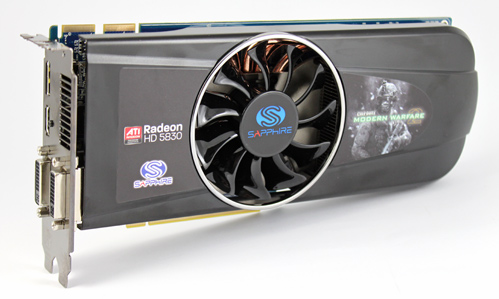
Radeon HD 5830 belongs to the gaming HD 5800 series, meaning it packs enough muscle and has what it takes to handle DirectX 11 effects. We’re saying this because we’ve already seen that some lower-end Evergreen offerings don’t really deserve the DX11 flag, and despite official support, they are pretty lacking in the performance department to really run DX11 games in all their glory. Fortunately, this is not the case with our today’s card.
Radeon HD 5830 features 1.79TFLOPs of computing power, its GPU runs at 800MHz and it has 1120 Stream processors. Compare this with the HD 5850’s 1440 SPs or the HD 5770’s 800 SPs, and you’ll get a clearer idea of what you should expect. While the HD 5870 comes with 16 thread processors (each has five ALU units that ATI calls stream cores) and 20 SIMD cores, the HD 5830 has 16 thread processors and 14 SIMD cores.
Like most Evergreen series cards, the HD 5830 uses fast GDDR5 memory running at 1000MHz (4000MHz effectively) and on a 256-bit memory interface. It has 56 texture units, compared to 72 on the 5850 and 40 on HD 5770. Just like on the HD 5770, it comes with 16 ROPs, which is half of what the HD 5850 has.
In a nutshell, AMD crippled the chip but clocked the GPU at 800MHz, which is higher than HD 5850’s 725MHz. Unfortunately, this reflects on the consumption and the card’s TDP stands at 175W, whereas the HD 5850’s TDP is at 151W. HD 5830’s minimum idle consumption is 25W whereas on the HD 5850, this number stands at 27W. In comparison, the HD 5770’s TDP is 108W and minimum consumption is 18W.
Apart from gaming potential, this card also uses ATI Stream technology enabling the HD 5830’s processor to be used for video and photo editing and taking some load off of the CPU. Support is not an issue as this technology already has backing by a few major players, most notably CyberLink, ArcSoft, ROXIO or Adobe. In case you’re interested in learning more on making apps with ATI Stream technology support, you can do so here. In fact, one of the currently hot topics is porting existing CUDA apps.
The packaging is similar to the rest of Sapphire’s HD 5800 offer – large.
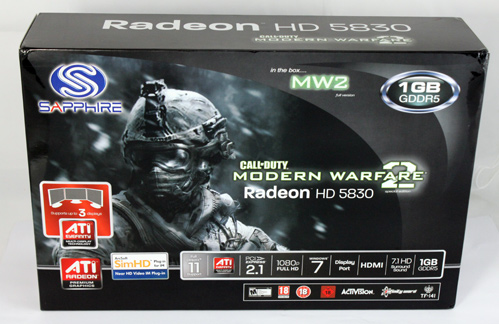
Instead of its “toxic” girls, this time around Sapphire made sure that Call of Duty – Modern Warfare 2 stands out as soon as you glance at the box, and naturally, the game comes with the card. Note that this is not the boxed version, but rather a coupon that will allow for downloading the game from Steam. You can learn more on that from the coupon.
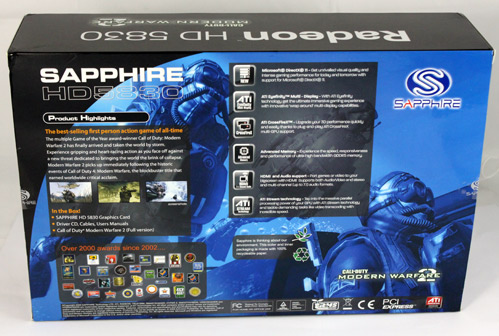
Within the package you’ll find a sturdy cardboard box that will make sure your card is safe and sound.
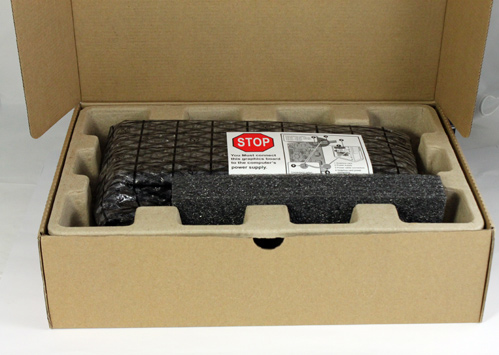
Apart from the game, the package contents are standard. The card features all the newer outs, but in case you require VGA, Sapphire ships an adapter as well.
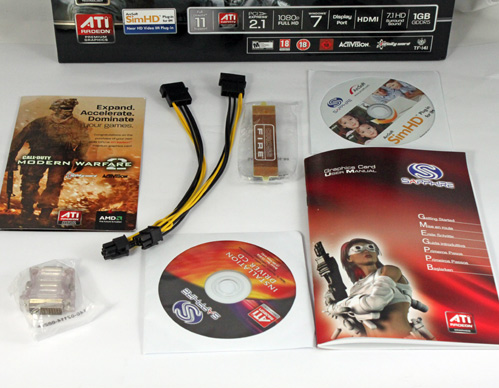
Sapphire HD 5830 comes with large, black cooling, which looks good, does a good job and runs pretty quietly.
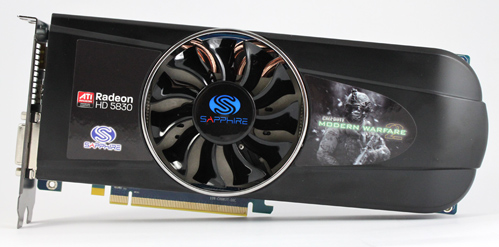
The card is 25.5cm long, which is 1.5cm longer than the HD 5850 and 2.5cm shorter than the HD 5870. It seems that the PCB on most of these cards is pretty similar if not identical, and the only difference among the cards is the cooling.
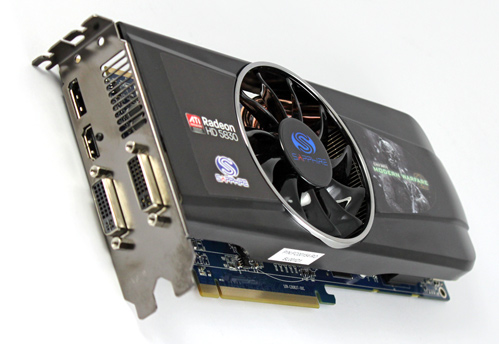
As you can see, the card comes with dual-slot cooling and the same I/O panel as on the HD 5870/5850. Sapphire HD 5830 comes with ATI Eyefinity technology, providing support for up to three monitors on one card. We must admit that playing a game and spanning the picture to three monitors is great fun, but it’s pretty expensive for most HD 5800 owners.
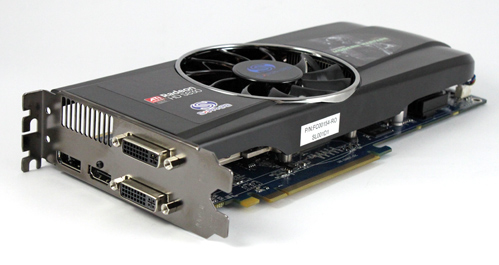
Sapphire HD 5830’s cooling is pretty quiet, thanks to the large dissipation surface. Sapphire uses 5 heatpipes and if you want to make the card even cooler, you can easily slow the fan down without worries of frying your card.
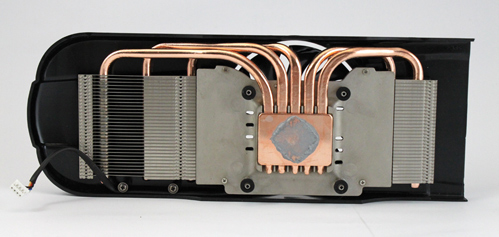
We took off the plastic hood, which guides and directs the air for more efficient cooling, so you can see the heatpipes.
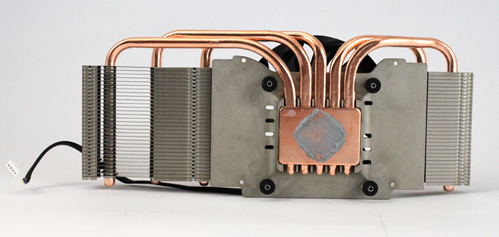
We still remember the pretty tall heatpipe solutions that exceed the height of the graphics card, but Sapphire did a great job here and you won’t see the heatpipes until you’ve taken the plastic hood off.

The fan is 8.5cm in diameter and it has curved fins for optimum airflow at lower RPMs. This reminded us of the Seaweed-Blade fan which we’ve first seen two years ago on MSI’s card, here.
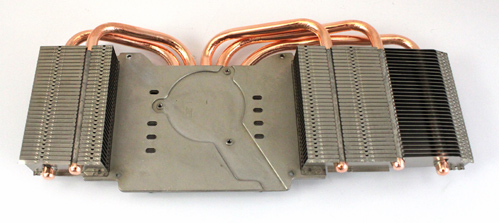
The fan is fixed with three screws and Sapphire placed it for optimum cooling, where the cooling fins on the sides are cooled as well.
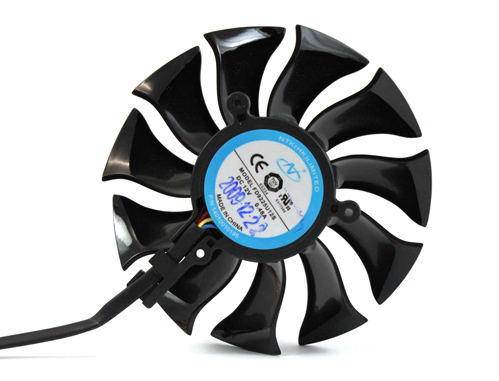
Sapphire’s HD 5830 uses Samsung gDDR5 memory on a 256-bit interface. All eight modules are on the front and the only cooling is provided by the fan.
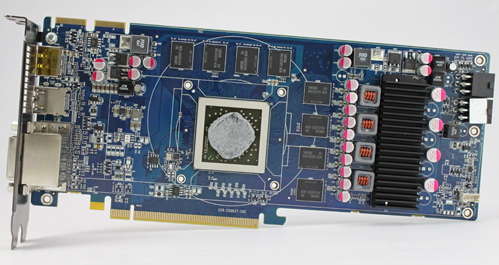
As you can see, HC04 says that this is a 0.40ns (5.0Gbps) memory which can easily run at much higher clocks than 1000MHz, which is the HD 5830 reference clock.
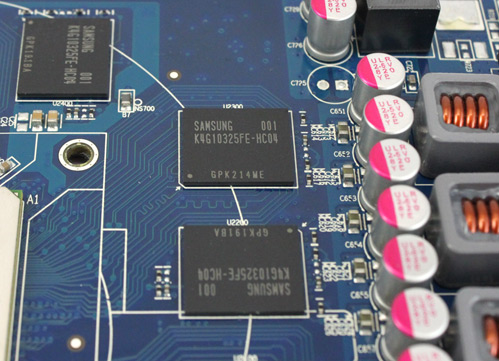
The card uses four phases for the GPU and one for the memory. As we already said, the higher clocks result in higher consumption than on the HD 5850 card.
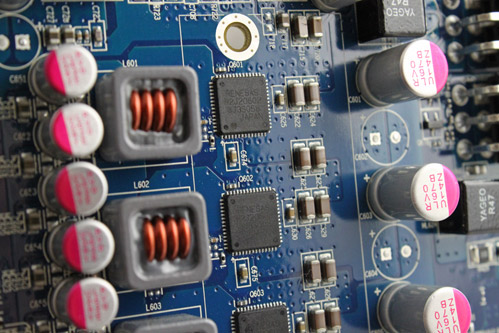
Power connectors are located towards the back of the card and are easily accessible. Next to it is the fan, which is powered via 4-pin connector and will enable users to keep tight reins on their fan’s RPM.
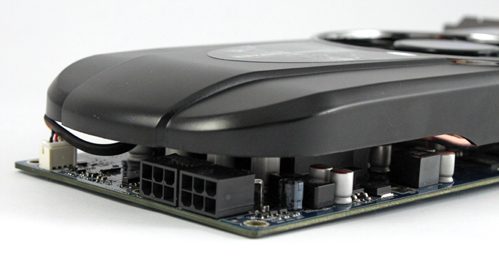
As you can see from the picture, the card is CrossFireX ready and the two CrossFire connectors confirm that.
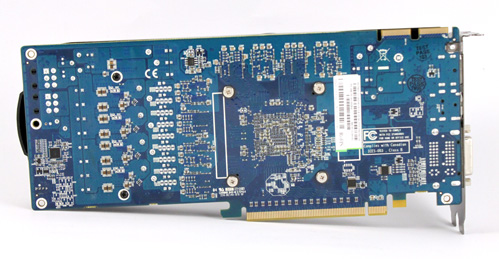
Testbed:
Motherboard: Elitegroup X58B-A (provided by Elitegroup);
Processor: Intel Core i7 Extreme 965 (provided by Intel);
Memory: 6GB Corsair Dominator 12800 7-7-7-24 (provided by Corsair);
HDD: WD VelociRaptor 300G 10,000RPM (provided by SmoothCreation);
Power Supply: CoolerMaster Ultimete 1100W (provided by Cooler Master);
Case: Obsidian 800D (provided by Corsair);
Fan Controler: Kaze Master Ace 5.25" (provided by Scythe);
Operating System: Win7 64-bit;
Driver: Catalyst 10.2 ; Forceware 196.34; ATI_Cypress_LE_8.703_RC2_Vista_Win7_Feb11
Sapphire HD 5830 is off to a nice start as it outruns the GTX 275 in 3DMark Vantage by 10%. Compared to HD 5850, the HD 5830 card is 17% slower but it beats the HD 5770 by about 30%.
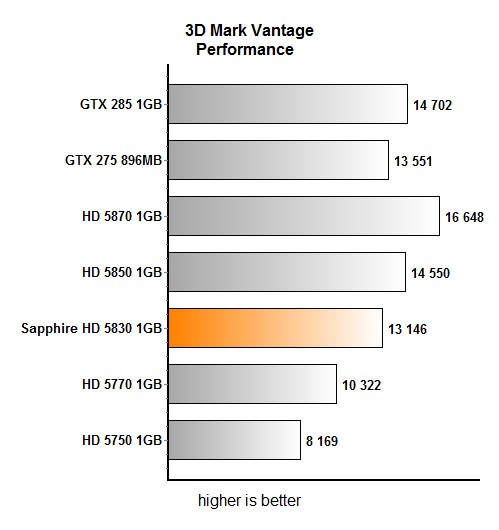
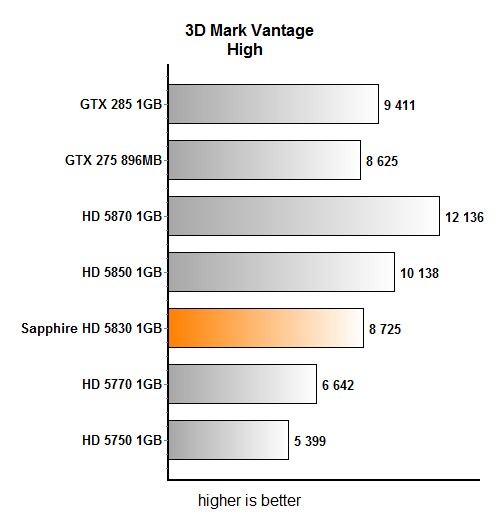
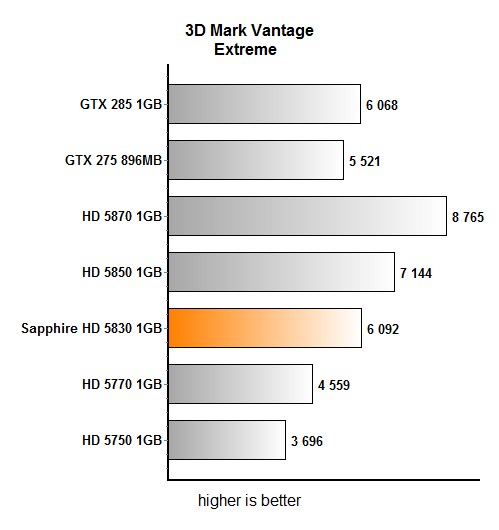
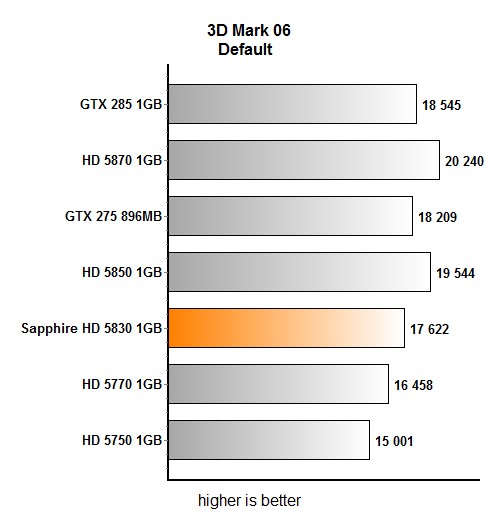
World in Conflict
GTX 275 manages to beat the HD 5830 and the performance difference is more evident in tests with antialiasing, where the GTX 275 wins by about 17%. The HD 5830 proves that it’s there to fill the gap between the HD 5850 and HD 5770 as its results are 20% lower and higher, respectively. So, Sapphire HD 5830 has what it takes to provide comfortable gaming in World in Conflict at all the resolutions, except on 2560x1600 with antialiasing on.
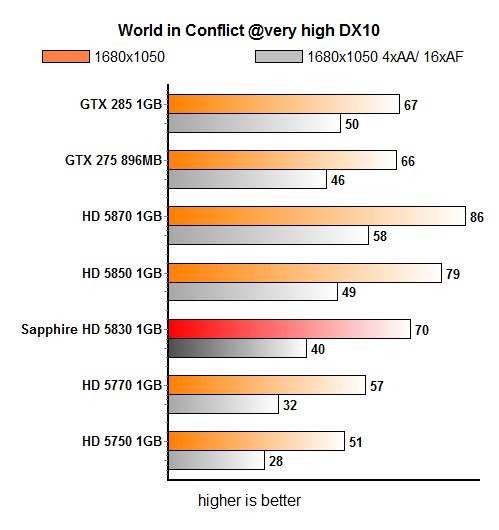
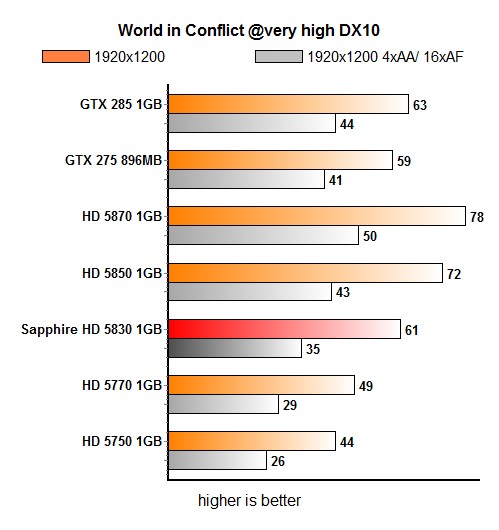
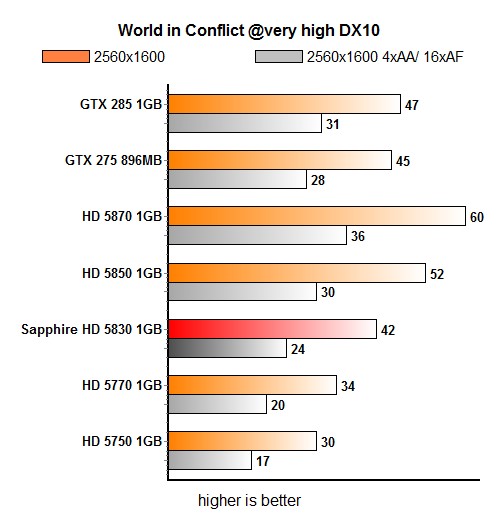
Dirt 2
Dirt2 features DirectX 11 effects and as such it clearly favors ATI. If you’re using Geforce cards, all of which are DirectX10, the settings will automatically choose DirectX9. This causes the GTX 275 to perform better on paper than HD 5850 or HD 5830 cards, but naturally at the cost of eye candy effects. We can confirm that Sapphire HD 5830 will spin Dirt2 at 2560x1600 with no trouble whatsoever.
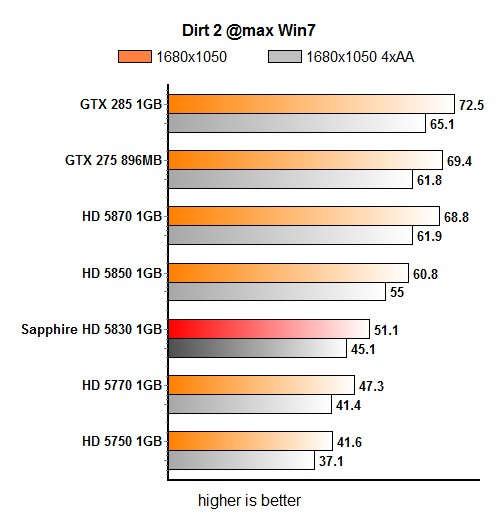
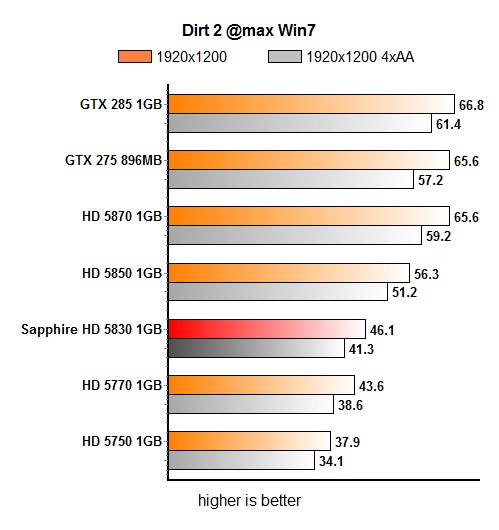
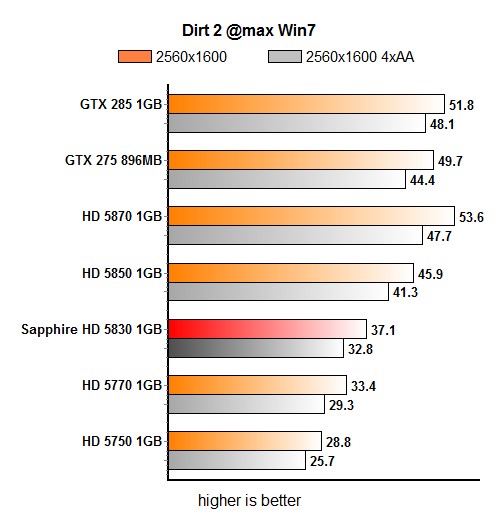
Batman Arkham Asylum
Although it is considered to be a game that works best when paired up with Geforce cards, AMD's Radeon cards are quite capable of delivering high framerate as well. The situation with HD 5830 is quite similar to the previous benchmarks, and despite the fact that it is slower than the HD 5850 card, it still manages to squeeze out playable framerate even at 2560x1600 resolution with 4xAA.


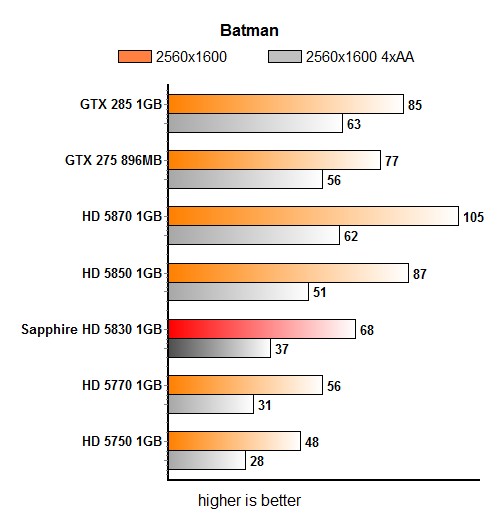
Left 4 Dead
In Left 4 Dead game, the HD 5830 manages to sneak really close to the Nvidia's GTX 275 and the gap is only 10FPS when 4xAA and 8xAF comes into game, but when those are disabled, AMD's HD 5830 even gives a higher framerate.
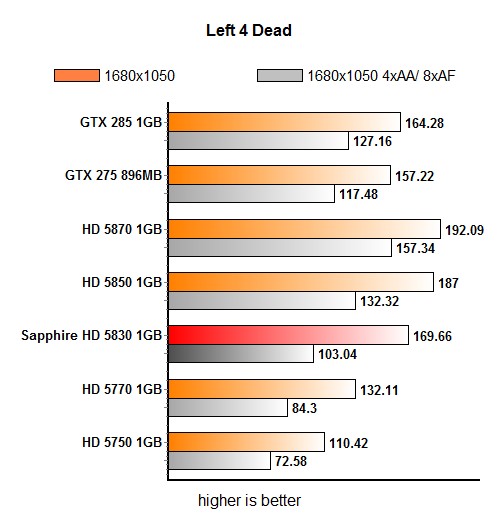
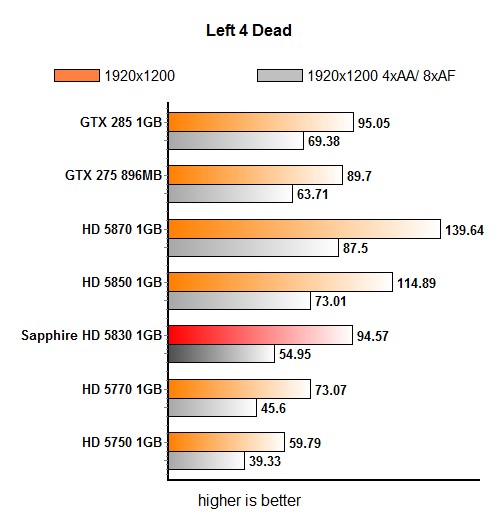
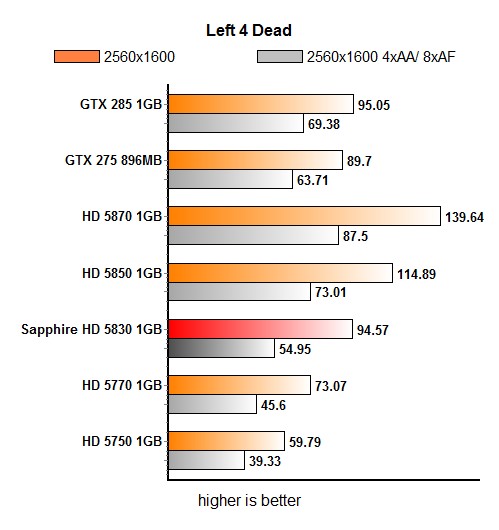
H.A.W.X.
Tom Clancy's H.A.W.X. should be the game where AMD's Radeon series should really shine, but unfortunately Nvidia did tweak its driver for this game, which means that HD 5830 still just trails the GTX 275, as in most of the benchmarks.
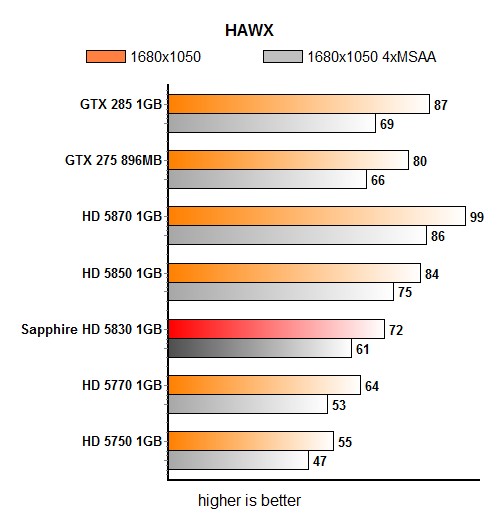
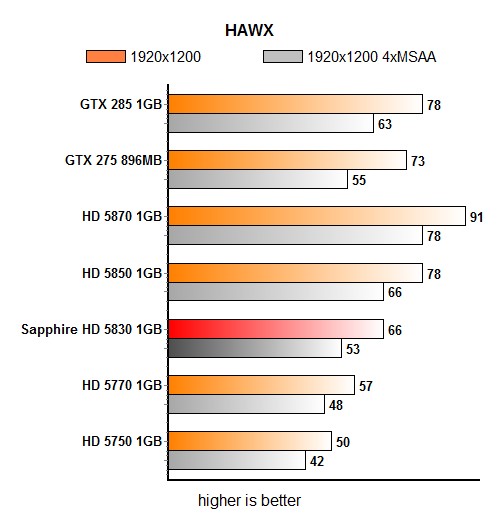
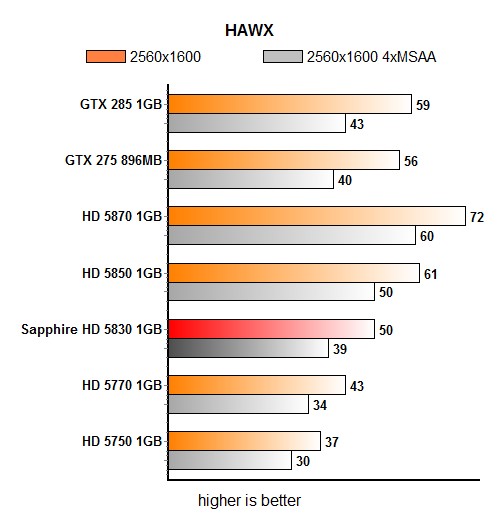
Crysis
Crysis is still a most favorite game benchmark although it is already a quite old game, but when you see that a top notch HD 5870 barely reaches playable framerate you can see why this game is such a good benchmark. The HD 5830 will get you up to 1920x1200 resolution with 4xAA but at 2560x1600 with the same settings it still falls below the, what we like to call, playable framerate.
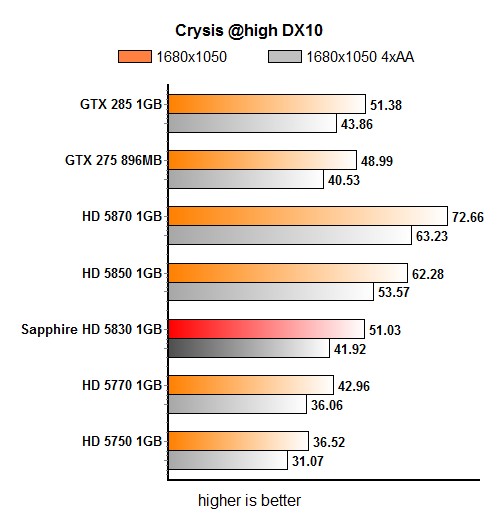
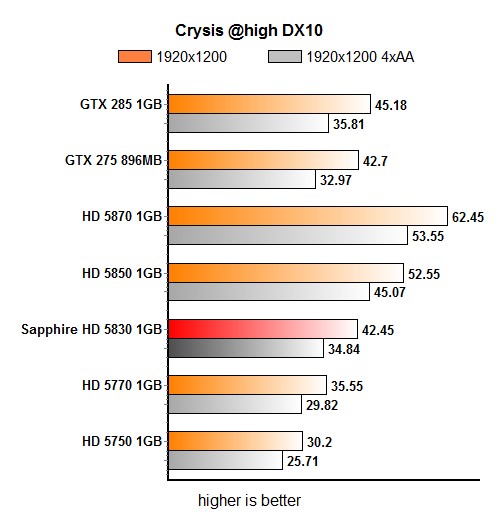
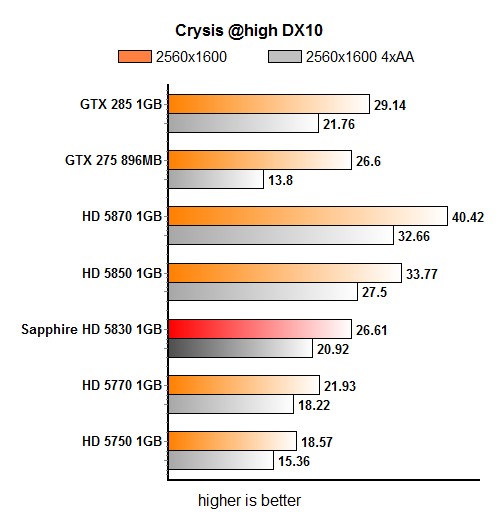
Far Cry 2
Far Cry 2 is the same story as with most of the game benchmarks, ATI's HD 5830 is somewhat slower than the HD 5850 and trails the GTX 275 quite well.

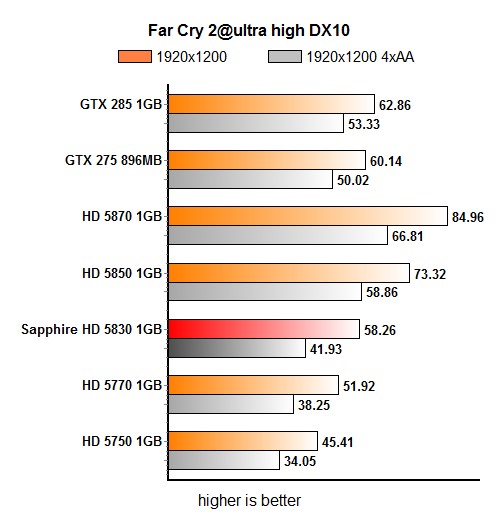
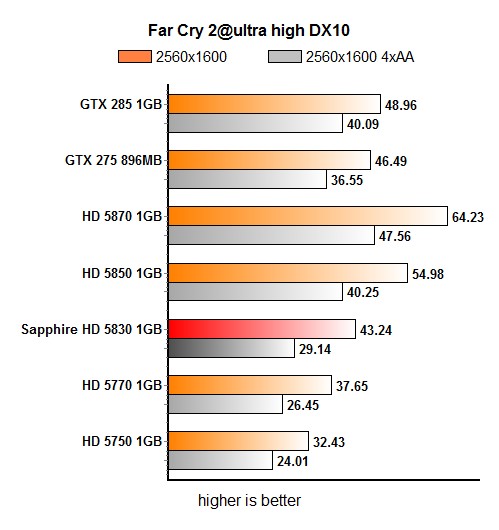
Sapphire HD 5830 runs at reference clocks – 800MHz for the core and 1000MHz for the memory. We easily pushed the card to 875MHz and the memory to 1200MHz (4800MHz effectively), which is the maximum allowed by ATI’s Overdrive.
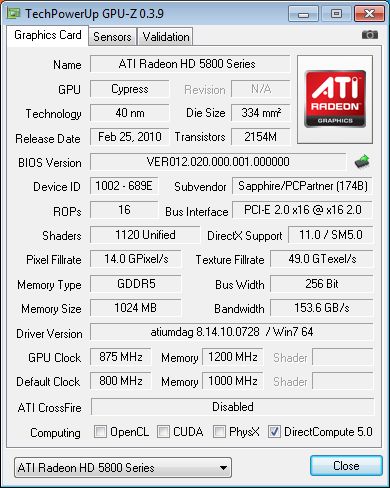
As far as consumption goes, the card will consume more than HD 5850 in 3D, but less when in idle.

The thermals are great, as you can see from the picture below, and we really liked the quiet cooler. In fact, the cooler is inaudible when the card is in idle mode and gets only a bit louder than that during more intensive tasks.

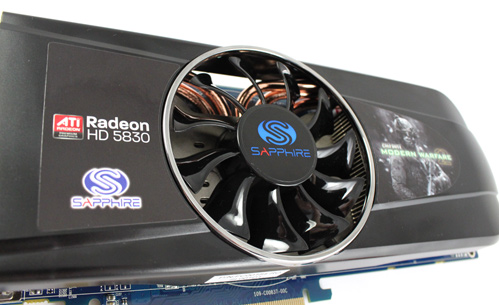
Conclusion
Performance-wise, Radeon HD 5830 sits between the HD 5850 and HD 5770. Unfortunately, AMD was supposed to launch the HD 5830 priced at $200, as this price segment was begging for an addition, but the price turned out to be priced at about $240, which is far from being a bargain in our book.
Sapphire is locked and loaded with its version of the HD 5830, and it comes with non-reference dual slot cooling and reference clocks. Our testing shows that the card indeed packs some nice punch for gamers on the budget, but the pricing still leaves a lot to be desired.
The mere fact that Radeon HD 5830 is an HD 5800 series card is proof enough that the card is a nice performer. Our today’s card is, just like the fastest single-GPU card HD5870, based on Cypress, but unlike the HD 5870, AMD disabled a few SIMD cores. So, the new HD 5830 features 1120 shaders whereas the HD 5870 comes with 1600. Furthermore, the HD 5830 comes with only 16 ROP units whereas the HD 5850 has 32. In order to compensate for these cuts, AMD clocked the card to 800MHz, which is not the case with the HD 5850 (725MHz). Unfortunately, while this will add to the performance it will also add to your power bill and the card consumes more power than HD 5850 when in 3D.
Sapphire did a nice job with its HD 5830 and ended up using an efficient and quiet cooling solution. Furthermore, the company thought about the gamer portion of its customers and included a free game as well – Call of Duty – Modern Warfare 2.
Reaching a verdict on the HD 5830 is not an easy task as its pricing is a really tough nut to crack. It’s very unfortunate that the lack of other (read Nvidia’s) DX11 hardware on the market resulted in AMD punishing its customers by such pricing, but they’ll get away with it as long as Fermi is away. So, we’ll cordially recommend the HD 5830 for some DirectX 11 gaming, as soon as its price drops to about €200.
